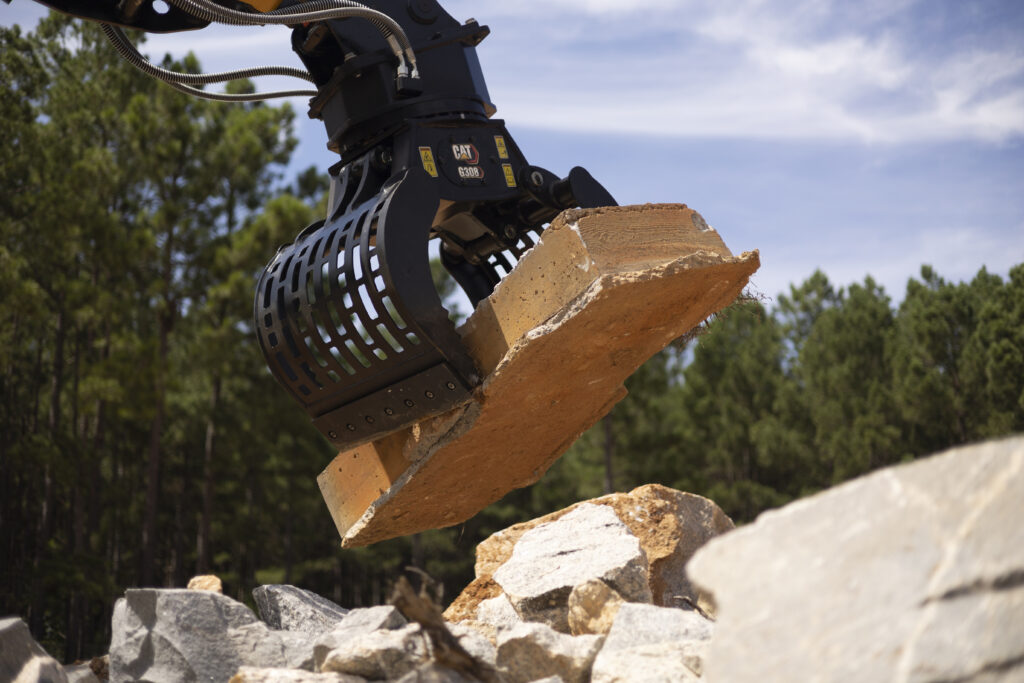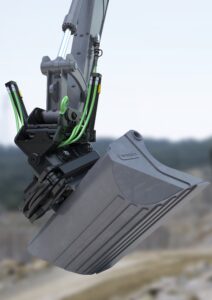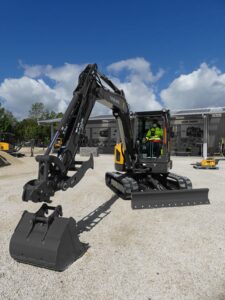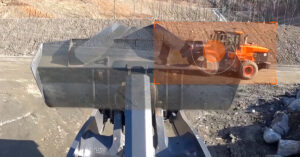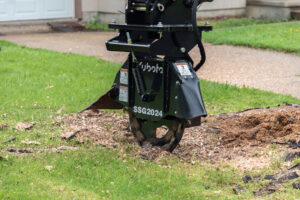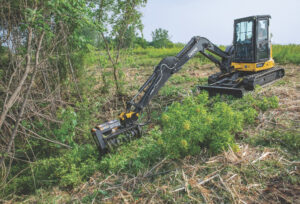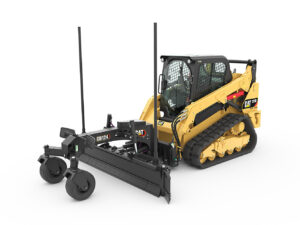
Equipment: The next generation
By TREENA HEIN
Construction Equipment Equipment TechnologyAutomation, visibility and control newest twists on machine attachments.
Buckets, blades and grapples may not be the first components that spring to mind when discussing smart technology in the world of heavy machinery, but as with most other segments of the construction sector, automation is hitting the latest generation of machine attachments as well, as manufacturers aim to make jobs easier and more efficient for operators.
“Overall, we are starting to see attachments that are focused on the operator,” says Jonathan Gardner, construction equipment product manager at Kubota Canada, as he sums up current general trends. He points to the proliferation of “smart” attachments that are making their way to market. These attachments, part of a new generation of equipment, are engineered so that the machinery senses the attachment that is being hooked up, automatically adjusting hydraulic flow and other parameters. Some systems will also sense such factors as pressure levels in the attachment, which can then be fed back to the operator.
Caterpillar’s suite of smart attachments includes its line of Smart Blades. These are described as offering “unique operating styles with fewer total hand movements that mirror heritage machines such as a Cat motor grader, Cat dozer or Cat backhoe loader.”
When using these blades, the in-cab screen will provide the operator a range of feedback about the attachment’s operation, such as slope or main fall.
The Volvo Dig Assist machine control system is another example where automation of attachments is making inroads on construction sites.
“On some of our excavator models, Dig Assist can also include what we call Active Control,” explains Todd Cannegieter, product manager for attachments and special applications at Volvo Construction Equipment. “This uses electro-hydraulics and the machine’s computer to guide the digging process and prevent operators from digging below the programmed depth.”
With Dig Assist, the boom and bucket movements are automatically adjusted to maintain an even grade and cutting angle. A somewhat similar technology, Swing Control, allows operators to pre-program the location of the trench and pile to assist in digging and truck loading. Although automatic, the company does advise that the system can be overridden with the joystick when necessary.
SPIN AND TILT
Not necessarily a new product for all companies in the sector, but a trend that is definitely picking up speed, is the use of rotator couplers for excavators in the 4- to 35-ton range. These units allow operators to spin and tilt buckets, enabling much more versatility in task completion. Most tiltrotators make it possible to rotate attachments a full 360 degrees, and to tilt 40 or 45 degrees, left or right.
After first having gained popularity in Europe, tiltrotators are now becoming more common in North America, says Jacob Sherman, product and dealer marketing manager at DEVELON.
“Operators can perform more sophisticated types of work,” he explains, “such as digging underground or around buried pipes to replace some work that was previously done with manual labour.”
Cannegieter adds that for trenching and ditch creation, tiltrotators enable operators to continue working without constantly repositioning the excavator, saving significant time for a given job.
“Picture digging around a manhole,” he says. “With a traditional excavator, you would have to move the machine several times to completely dig it out. With a tiltrotator, you can maneuver the bucket completely around the manhole from one spot.”
Volvo excavators now feature Steelwrist tiltrotators, which are suitable for trenching in confined spaces, ditch creation, and cleanup, grading and anything that requires multiple attachments. DEVELON has also partnered to offer Steelwrist tiltrotators and a rotating grapple for its crawler excavators and mini-excavators.
Among John Deere’s base-coded tiltrotators, attachments and packages for excavators in the 2.6- to 35-ton size classes, machines that are five tons and larger come with a feature called EC-Oil, which allows for fast hydraulic attachment changes – estimated by the company to take about 15 seconds without leaving the cab.
At Caterpillar, the manufacturer has launched a new TRS4 tiltrotator for its MHE mini excavators for general underground, utility, homebuilding and grading applications. Scott Britton, Cat attachments marketing manager, explains that because the TRS is available in all common couplers (pin-on, pin grabber or S-style), contractors can now purchase this advanced attachment without needing to purchase a much larger machine.
The TRS4 has an oil bath lubrication for the worm gear and screw, which he says reduces the maintenance service interval and reduces the overall wear when compared to a grease-only setup.
QUICK COUPLERS
In addition to expanded tilting options, the industry is also seeing advancement on coupler options to help attach the attachments to the machine.
For example, Volvo now offers two main kinds of quick-connect couplers, including one that has just been recently updated. The S-type of Volvo’s dedicated coupler/ bucket interface was recently redesigned to incorporate operator feedback in the cab for the coupler-to-attachment interface. Also available from the company is its hydraulic universal quick coupler with front-pin lock, which picks up all Volvo direct-fit attachments.
ADVANCING VISIBILITY
Cameras are helping make jobsites safer for workers and operators, and better visibility is also a factor when it comes to the use of attachments, helping improve both accuracy and safety. DEVELON’s Sherman points to optional all-around view monitoring camera systems available on his company’s equipment that display a full view of the excavator’s surroundings, all around the machine but also of the top, that can assist operators work efficiently.
But visibility is not only available via windows and cameras that monitor the perimeter of machines. DEVELON offers its industry-exclusive transparent bucket technology for its -7 Series wheel loaders. First introduced in 2021, the feature is now standard on all 2023 -7 Series wheel loaders.
The company’s wheel loader product manager, Bill Zak, says that the system’s processor automatically adjusts the input from two cameras into “a single image that makes the bucket appear transparent on the wheel loader’s in-cab monitor.” This provides an unobstructed view, he explains.
SNOW, STUMPS, MULCH AND BRUSH
Of the three new attachments introduced by Kubota Canada for 2023, two of them are for excavator equipment. These include a plate compactor for 1.5- to 9-ton excavators and a stump grinder for 3- to 8-ton excavators. The company’s stump grinder, which allows an operator to grind stumps up to 10” below ground with the 24” cutting wheel, can be used on multiple machines, so long as the operator has the appropriate hitch.
The other new Kubota attachment is a snow blower for compact track loaders and skid steer loaders. It has a foldable chute and a serrated auger designed to allow it to tackle all types of snow conditions.
Also aimed at clearing sites, John Deere’s new RE40 and RE50 brush cutters work with John Deere excavators but are also compatible with many other 3.5- to 10-ton excavators on the market. Similarly, the ME36 and ME50 mulchers work with John Deere excavators and many other 5- to 10-ton excavator models. Both have a new polycarbonate front window guard to better protect the operator from flying debris.
GRAPPLES
By fall, Cat will be releasing its new G206 and G208 multipurpose grapples. They’re suited for picking up larger items such as hardscape blocks, misshapen stones, pipe, trees and general construction debris.
“The grapple paddles are bypass style that can collapse down like a hug, making them ideal for easy storage and easy transportation,” Britton explains. “The rotation for the grapple is all done via the TRS.”
Featuring rotation motors right in their grapple heads, Cat’s new G306 and G308 demolition and sorting grapples, which are set for release later this year, do not require an advanced product like a TRS. The full rotation comes from a secondary auxiliary circuit on the machine.
These attachments feature grapple paddles with hardened edges that will touch tip-to-tip for picking and placing materials in a demolition-type application. The paddles can also go fully vertical relative to the cutting edge, a unique feature that Britton says allows the grapple to be placed up against a tight corner or wall.
A holding valve ensures that what is picked up stays within the jaws without the need to continue engaging the auxiliary circuit and potentially damaging the item being picked up.
EXPANDED COMPATIBILITY IN BLADES
Caterpillar recently introduced a kit making its GB120 and GB124 smart grader blades backwards compatible with all Cat D and D2 generations of machines. When the blades hit the market in 2020, they were restricted to the company’s D3 generation. The blades offer cross slope assist as a standard feature, with the option to add grade control via laser, dual Global Navigation Satellite System (GNSS), sonic or Universal Total Station (UTS).
Working with Trimble, Cat also recently announced the capability to add full 3D GNSS grade control to their Smart Dozer Blades with both cross slope and main fall assist on Cat 289D3, 299D3 and 299D3 XE compact track loaders. Site plans can be loaded for contouring complex designs with the maneuverability of a compact track loader versus that of a larger Cat D1 dozer.

